

Earth Month Sustainable Living: City of Victoria Green Plans
The city of victoria’s plans for the future.
When we think about implementing and developing a more sustainable future, we look to our leaders for guidance, help, and resources. In 2018, the City of Victoria developed a Climate Leadership Plan, outlining sustainability goals, targets, and actions for Victoria.
To help make the Plan and all of the fantastic information it contains more accessible, I summarized the Plan, including an introduction and its five main sections: Low-Carbon High-Performance Buildings, Low-Carbon Mobility, Low-Carbon Waste Management, Municipal Operations, and Adapting Early.
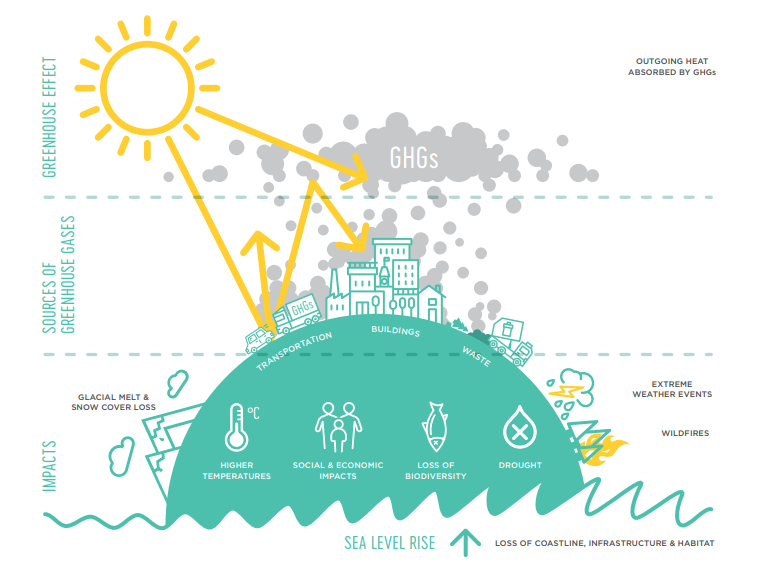
Introduction
The City of Victoria starts off by introducing its vision of a “vibrant, healthy, and prosperous community, fueled by renewable low carbon energy systems, and designed and integrated in ways that promote a high quality of life for all Victorians” by 2050.
The Plan discusses where we’re at right now. The main areas contributing to Victoria’s carbon footprint are “the energy used to heat buildings, the fuels that propel vehicles, and what becomes of waste after it is discarded”. In 2017, Victoria emitted 370,000 tonnes of GHGs, 50% of which came from buildings, 40% from transportation, and 10% from waste. Our electricity is relatively clean, however, with nearly all of BC’s power grid supply coming from renewable hydropower. We are already at 40% of our energy being renewable!
It also outlines their goals for what Victoria will look like by the mid-century. The City wants to reduce our greenhouse gas (GHG) emissions by 80% and shift from GHG-intensive fossil fuels to 100% renewable energy by 2050. This does not mean that we are starting from scratch. We are moving in the right direction already; we just need to intensify our efforts.
Finally, it lists the ten Climate Leadership Planning Principles that will guide the next steps and inform the process.
- Lead and inspire: The City will be a regional and national leader on climate mitigation and adaption, taking urgent action to drive innovative GHG reductions.
- Harmonize climate action to secure co-benefits: GHG reduction should be integrated into City planning in all areas, including health, safety, affordability, etc.
- Universal accountability: All Victorians have an important role to play in reducing GHGs and should be encouraged to take meaningful action.
- Make energy visible: Data for Victoria’s energy use, GHG performance, and climate impacts should be available and known to help drive effective change.
- Evidence-based decisions: Decisions regarding energy usage and GHG reduction should be socially minded, cost-effective, and supported by science and technology.
- Renewable energy for all: All Victorians, regardless of circumstances, must have easy access to affordable and renewable energy options.
- Dismantle barriers: The City will remove barriers to rapid decarbonization of our energy and support smart energy choices in their policies.
- Climate resilience is developed early: To avoid the most disruptive economic, social, and environmental impacts of climate change, Victoria must take urgent, early, and meaningful action.
- Think globally, change locally, partner regionally
- Track and Adjust: The City will track and report on its progress and targets every year, making adjustments if and when needed.
The “largest, least expensive, most benign, most quickly deployable, least visible, least understood, and most neglected way to provide energy services” is to maximize energy efficiency. That is one of the places that is first on the priority list for the City and where it wants us all to start.
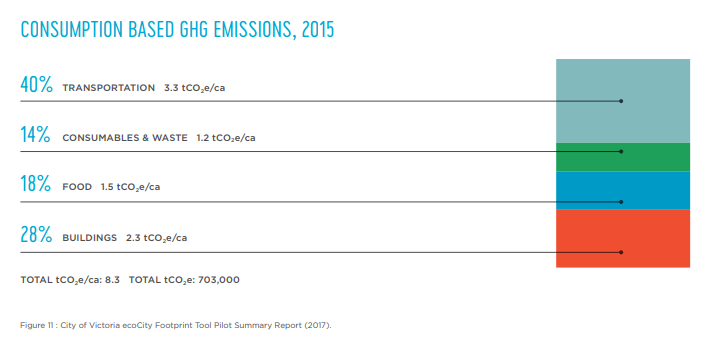
Low-Carbon High-Performance Buildings
Building-related GHGs account for 50% of Victoria’s emissions and mainly come from the combustion of heating oil and natural gas. The City plans to work with government partners and local stakeholders to “develop strategies and actions to make low carbon building retrofits affordable and timely”.
Switching from oil and gas furnaces to air source heat pumps could save up to 50,000 tonnes of carbon dioxide every year. That’s more than 13% of what we need to cut to reach the 2050 targets! A heat pump upgrade can also save between 40% and 75% off homeowners’ annual heating bills.
- All buildings are highly energy efficient
- All buildings are powered by renewable energy
- By 2030, all new buildings are “net-zero energy ready”.
- By 2050, all existing buildings meet new high-efficiency standards
- By 2030, heating oil is phased out.
- By 2050, all buildings exclusively use renewable energy.
Actions Already Being Taken
- Adopt the BC Energy Step Code, creating a road map towards net-zero energy ready buildings by 2030
- Renew the City’s Sustainability Checklist to include Step Code requirements for new buildings, as well as sustainable building design elements that align with City goals
- Design and deliver customized deep energy retrofit programs for rental apartment buildings
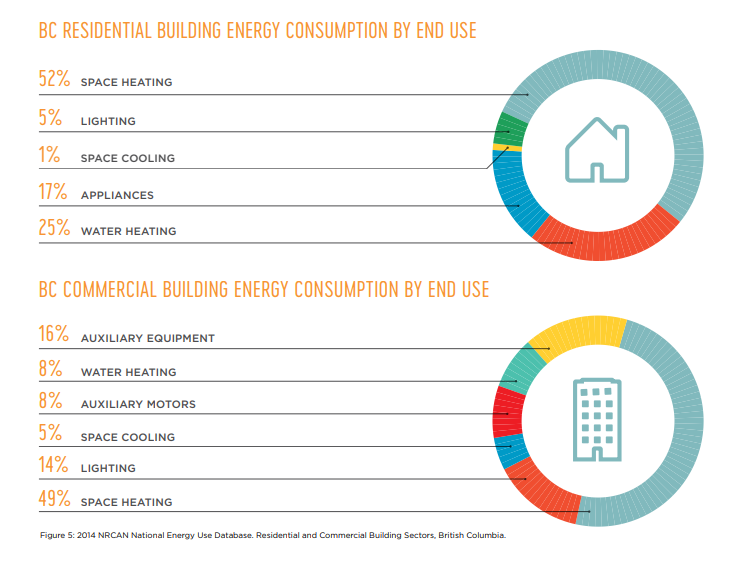
Low-Carbon Mobility
Transportation makes up 40% of our GHG emissions, with most of that coming from burning gasoline in our passenger vehicles and diesel fuel in commercial vehicles. The City wants to “make alternatives to gasoline and diesel-fuelled vehicles more compelling” by encouraging the use of renewably powered vehicles, expanding walking and cycling infrastructure, and more!
Their plan is to “reduce the number of vehicles in Victoria, the number of kilometres they are driven, and the frequency of driving alone.”
- All Victorians have access to low carbon, high-performance, and affordable multi-modal transportation
- Vehicles in Victoria are powered by renewable energy
- Smart land-use minimizes transportation emissions
- By 2030, 25% of all trips by Victoria residents are taken by public transportation.
- By 2030, 100% of BC Transit business are renewably powered.
- By 2030, Victoria residents choose walking and cycling for 55% of all trips.
- By 2030, renewable energy powers 30% of passenger vehicles registered in Victoria, and 100% of passenger vehicles are renewably powered by 2050.
- By 2030, 30% of commercial vehicles operating in Victoria are renewably powered.
- By 2030, 100% of Victoria’s neighbourhoods are “complete” by design with substantial transportation system diversity.
- Complete the City’s Sustainable Mobility Strategy (SMS), which will allow the city to develop the management systems, programs, and other tools to optimize and transform the movement of people, goods, and services. As part of the SMS, the City will set specific targets for reducing single-occupancy vehicle use, vehicle kilometres traveled, and vehicle ownership. It will also adopt multi-modal service indicators and identify performance criteria for “complete” neighbourhoods and transportation service diversity
- Invest annually in the design and construction of new walking and cycling infrastructure, including secure bike parking in the downtown core and in village centres.
- Expand EV charging stations in City parkades, recreation centres, community centres, and public spaces.
- Invest in ‘transit-signal priority’ measures to reduce transit wait times in the downtown core.
- Sponsor community-led events, educational programs, and celebrations that encourage the use of low carbon transportation.
- Advocate for energy performance requirements in provincial ride-sharing regulations.
- Expand car share services in the downtown core and village centres.
- Support the expansion of electric buses, including BC Transit and other commercial fleets, through infrastructure and permit programs.
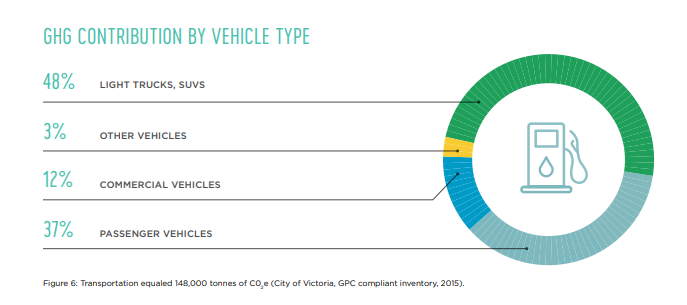
Low-Carbon Waste Management
GHG emissions from waste mostly come from organic materials in our landfill breaking down. This releases methane, which is 25 times more potent than CO2. The organic waste in Hartland Landfill produces the equivalent of 27,000 tonnes of CO 2 , which amounts to about 7% of our community’s emissions.
Kitchen scraps and food waste are still the largest source of waste at our landfill, roughly 21% of it or 75 kilograms per person per year. Other organic materials that generate methane at a slower rate, such as wood, paper, and textiles, make up an additional 38% of Hartland’s intake. “Reducing GHGs from waste will require major reductions in waste disposal.”
The best and smartest way to reduce waste-related GHG emissions is to reduce the amount of waste we generate in the first place.
- Organic materials are managed to avoid GHG emissions (ie: food and yard waste, wood, paper, textiles)
- Eliminate 100% of food and yard waste sent to the landfill by 2030.
- Eliminate 100% of other organic materials sent to the landfill by 2030.
- Capture methane from collected organic waste to provide renewable energy by 2025.
- Continually improve the residential kitchen and yard waste collection and diversion programs, including for multi-family residences.
- Foster behaviour change to reduce food waste through the “Love Food Hate Waste” educational campaign.
- Partner with CRD to deliver a regional, industrial treatment facility for organic waste by 2025.
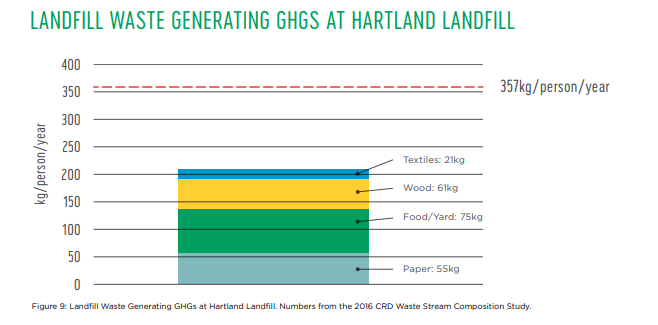
Municipal Operations
Much like the rest of Victoria, the City’s corporate GHG emissions come from “the combustion of fossil fuels to provide heat and hot water to buildings and to operate the City’s fleet”. They account for about 1% of our total community emissions, which is equivalent to 3,400 tonnes.
The City plans to reduce GHGS by upgrading efficiency in buildings, improving vehicle efficiency and reducing fuel demand, and shifting from fossil-fuel burning equipment to those that run on electricity, renewable natural gas, hydrogen, or advanced biofuels. For instance, in 2016, the City added “three e-bikes, eight hybrid vehicles, and nine electric vehicles to its fleet”. The Victoria Conference Centre now runs on 100% renewable natural gas. The City has replaced 6,700 street lights with energy-efficient LEDs to reduce energy use by 50%, “avoiding an estimated $200,000 in energy costs per year”.
- The City is a recognized leader in climate mitigation and adaptation.
- The City takes integrated and informed climate action.
- The City will provide timely and accurate data supporting strong climate mitigation and adaptation actions.
- By 2040, all City facilities are powered 100% by renewable energy. All new City facilities are renewably powered.
- By 2025, all City power tools and small engine-driven equipment are renewably powered.
- By 2040, 80% of the City fleet is electrified or renewably powered.
- By 2020, capital and operating plans are informed by climate data, carbon pricing, and the City’s GHG reduction targets.
- By 2022, the City has developed a “triple bottom line” accounting system that guides City business planning by assessing and balancing environmental and social risks and financial costs and opportunties.
- By 2022, partner with other local governments and the region to develop a community-accessible Energy and GHG information management System (EGIMS) to define, communicate, and track community energy and GHG reduction across all sectors.
- Establish a two-year staff corporate energy and climate action position using matching funds from an external partner. Join BC Hydro’s Corporate Energy Manager Program.
- Plan for City vehicle electrification systems and networks.
- Implement fleet telematics to identify vehicle and operational energy use patterns to inform decision-making.
- Reduce per-vehicle GHG emissions through fleet operation and maintenance as well as vehicle right-sizing.
- Partner with other municipalities and orders of government to support the development of the full suite of EVs required by municipal fleets.
- Develop the City’s web-based GHG / Energy education, awareness, and information exchange portal to promote information sharing and empower the public to achieve measurable, and trackable, GHG reductions.
- Pilot new technologies in City-owned assets to assess suitability for broad community application.

Adapting Early
In coming years, Victoria will “experience hotter and drier summers, warmer and wetter winters, rising sea levels, and more extreme storms” even if the global community reduces future carbon emissions. It is a matter of the severity of these issues and their effects.
With hotter summers, trees, parks, and gardens will be stressed, which could affect our ability to find and grow local, affordable food. Local flooding would be a more regular occurrence due to more intense rain storms and sea levels rising. Rising sea levels can also cause coastal erosion and ecosystem damage to our beautiful waterfront environment.
By acting early to anticipate climate change and its effects on our homes and the environment, we will avoid disruptive and expensive action later. “Climate change could cost Canada up to $43 billion per year by mid-century”, but that price tag “could be halved through early action”.
- All climate-related risks to City infrastructure are minimized through early and wise planning and action.
- Victoria’s natural environment flourishes in a changing climate.
- All Victorians are empowered and prepared for climate impacts and emergencies.
- Climate resilience is embedded into all City business.
- The City’s infrastructure and services are ready to protect and respond to the risks associated with a changing climate.
- Natural habitats support healthy fish, wildlife, and plant populations and healthy ecosystem function.
- The community is knowledgeable and prepared to address the impacts from a changing climate.
- The City incorporates best practices in risk communication covering all climate hazards.
- Climate resilience enhances the quality of life for all Victorians, especially the most vulnerable.
- Develop the ‘business case for adaptation’ to demonstrate the benefits of taking early action
- Conduct a community-wide climate vulnerability and risk assessment
- Assess how existing City plans incorporate climate risk and identify opportunities to align with ongoing and future City business.
- Seek funding, investment, and partnership opportunities to enhance the speed and quality of adaptation initiatives.
- Minimize flood risks through natural and engineered stormwater infrastructure.
- Continue to integrate climate change impacts in environmental management decisions.
- Increase native plantings on City-owned and -managed land to enhance biodiversity and support ecosystem migration
- Continue to improve public communication methods in advance of extreme weather events.
- Continue to integrate climate risks into emergency preparedness and recovery planning.
- Support projects and programs that increase resilience in populations vulnerable to climate change.

More Information:
For more details on how the City of Victoria plans to inspire and elicit sustainable change, check out the full Climate Leadership Plan document.
Another resource to check, including programs and rebates, is the City of Victoria’s webpage on Sustainability .
We Can Rise to the Challenge!
Meeting BC and Canada’s environmental climate change goals for 2050 will be a challenge. It will mean we need to rethink how we live our lives, research better options, and develop strategies for reusing resources and reducing waste. We will all need to work together, but it is possible and we can do it!

Sign up for our newsletter to stay up to date on the latest events and more!
SUBSCRIBE TO THE DVBA NEWSLETTER
Marketing Permissions
The Downtown Victoria Business Association will use the information you provide on this form to send news and updates about events or giveaways. Please let us know all the ways you’d like to hear from us:
You can change your mind at any time by clicking the unsubscribe link in the footer of any email you receive from us, or by contacting us at [email protected]. We will treat your information with respect. For more information about our privacy practices please visit our website. By clicking below, you agree that we may process your information in accordance with these terms.
We use Mailchimp as our marketing platform. By clicking below to subscribe, you acknowledge that your information will be transferred to Mailchimp for processing. Learn more about Mailchimp’s privacy practices here.

200-764 Yates Street, Victoria BC
250-386-2238
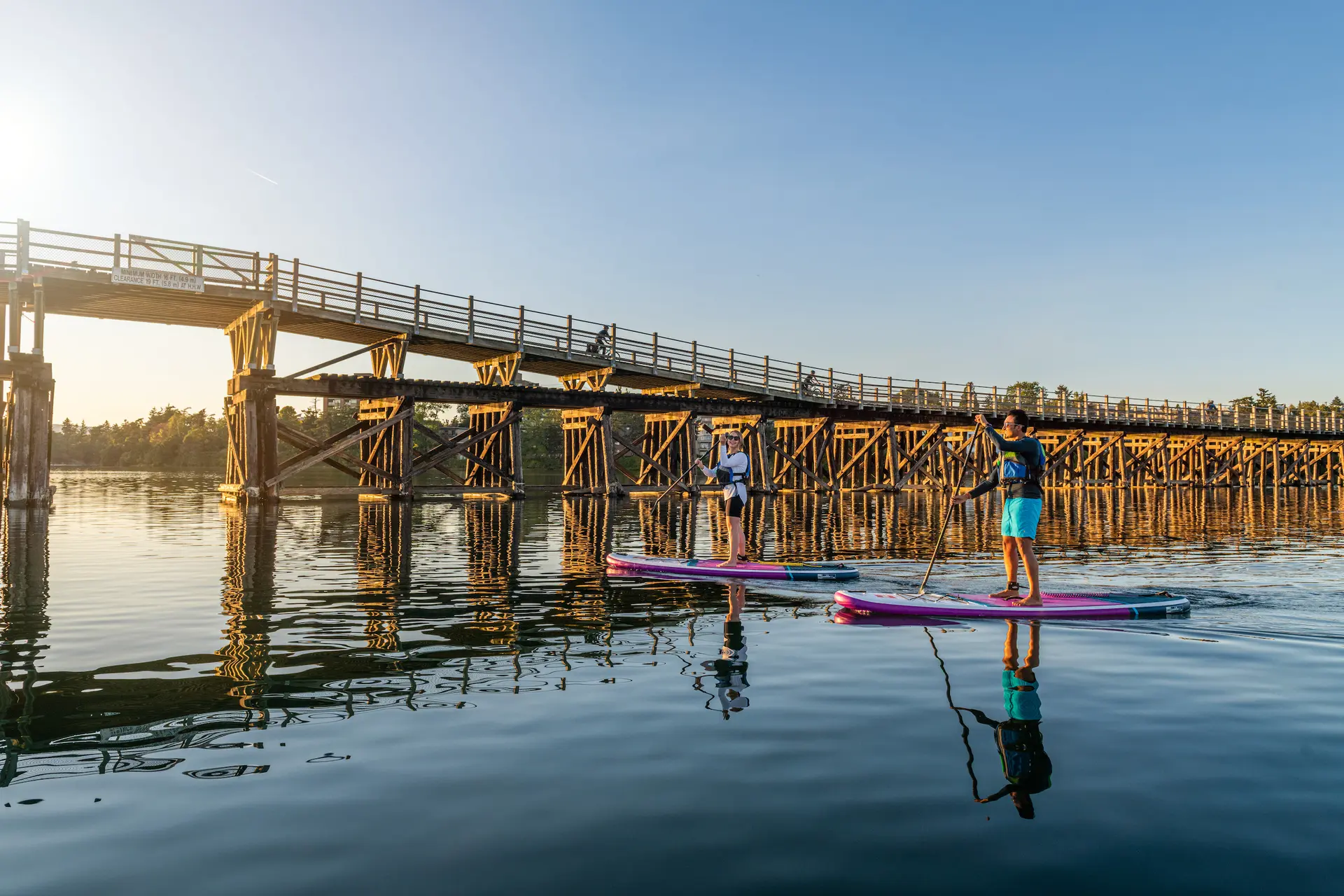
Sustainable Greater Victoria
Greater victoria is a biosphere certified destination.
So, what does that mean? Travellers around the globe are seeking out sustainable and eco-friendly travel options that match their values. The Responsible Tourism Institute’s Biosphere certification is a guarantee of environmental, economic, and socio-cultural balance that meets the needs of modern travellers. Biosphere Certification is a commitment to the 17 Sustainable Development Goals of the United Nations , the World Charter for Sustainable Tourism +20 , and the COP21 Paris Agreement to combat climate change.
Growing a Better Future
There’s something about Greater Victoria that fosters a freedom to think outside the box. We proudly blaze our own trails and do things in our own unique way. Our influence and impact on the world reach far beyond our shores. Throughout our history, our creativity and ingenuity have sparked new ideas and innovations. We take our time to do things right. Our commitment to sustainability, ocean research and new technology continue to show how we can lead the world from our little piece of it.
We’re not far away, just further ahead.
Sustainable Accommodations
Don't lose sleep over your carbon footprint. From carbon neutral to climate positive, Victoria's hotels pair sustainability with service brilliantly.
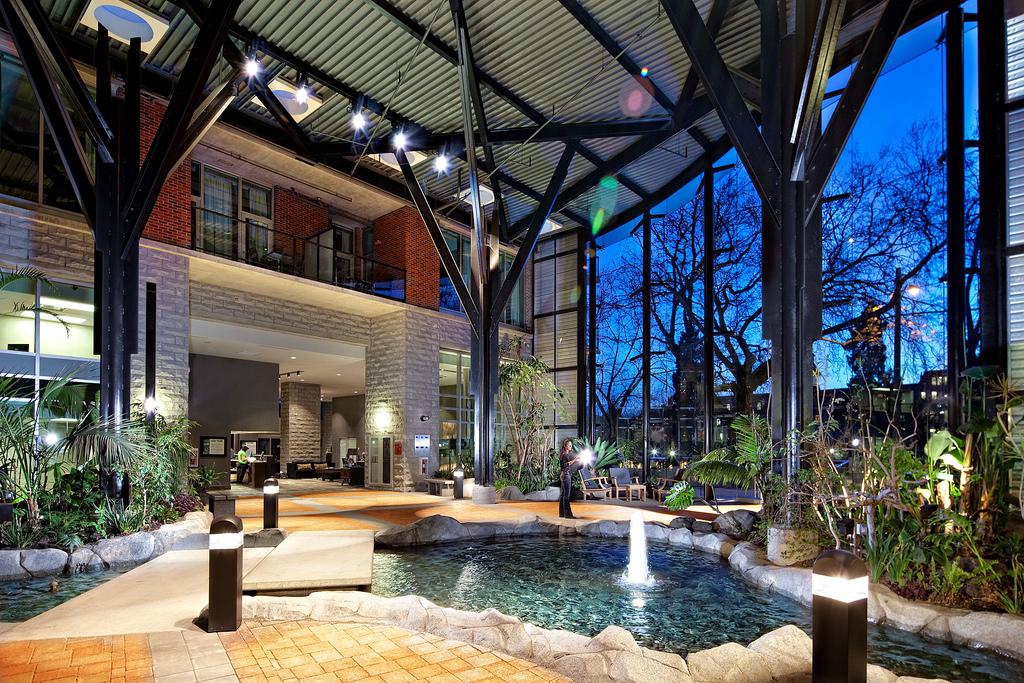
Sustainable Business in Victoria
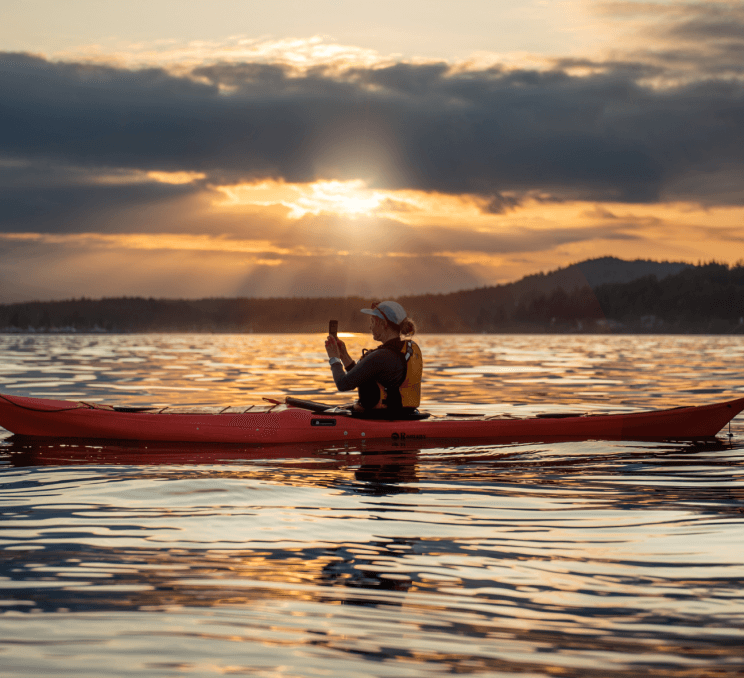
Sustainable Attractions
Victoria blends eco-tourism with cosmopolitan flare. Connect with the land, sea, and air in our one-of-a-kindland on the Pacific coast.
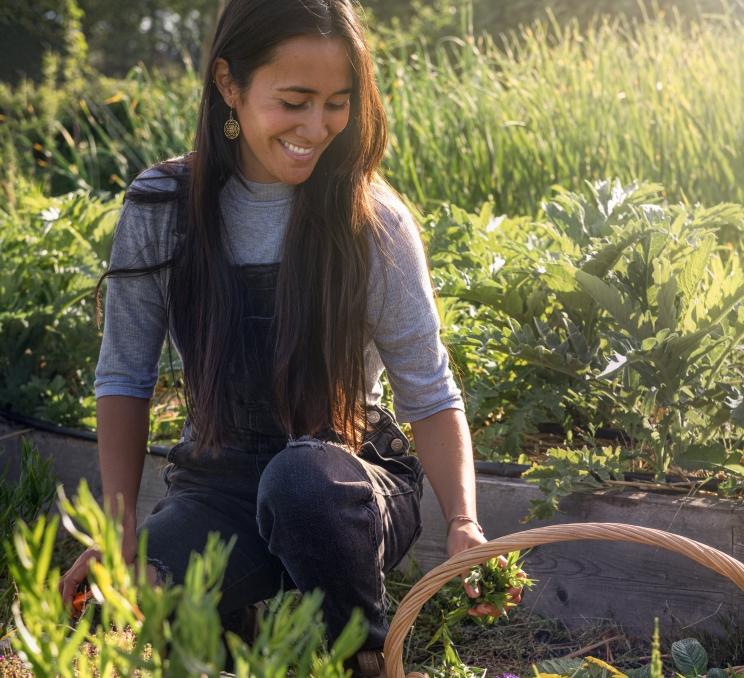
Sustainable Dining
In Victoria we measure farm-to-table on a scale of metres not miles. Discover local organic flavours farmed and foraged steps from our downtown core.
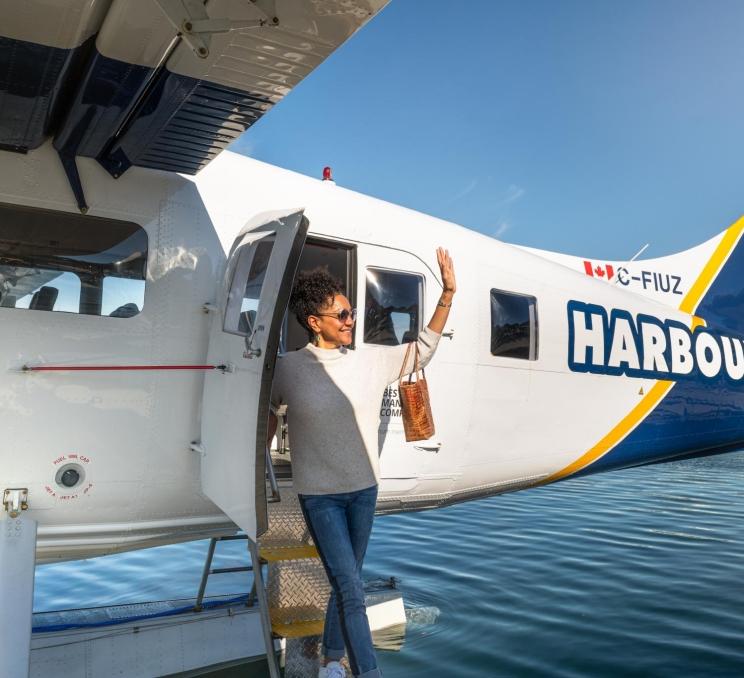

Sustainable Transportation
As an island destination, getting to Victoria is part of the adventure. No matter how you plan on travelling, there's a sustainable provider for you.
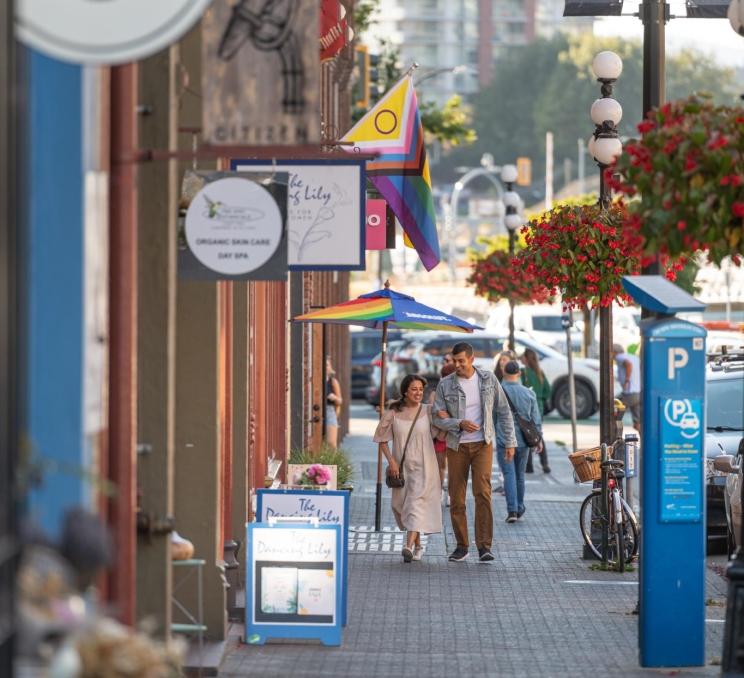
Sustainable Shopping
In Victoria, sustainable shopping is a way of life! From local markets to eco-friendly stores, the city offers a treasure trove of options for conscious consumers, making it easy to find great products that are kind to both your wallet and the planet.
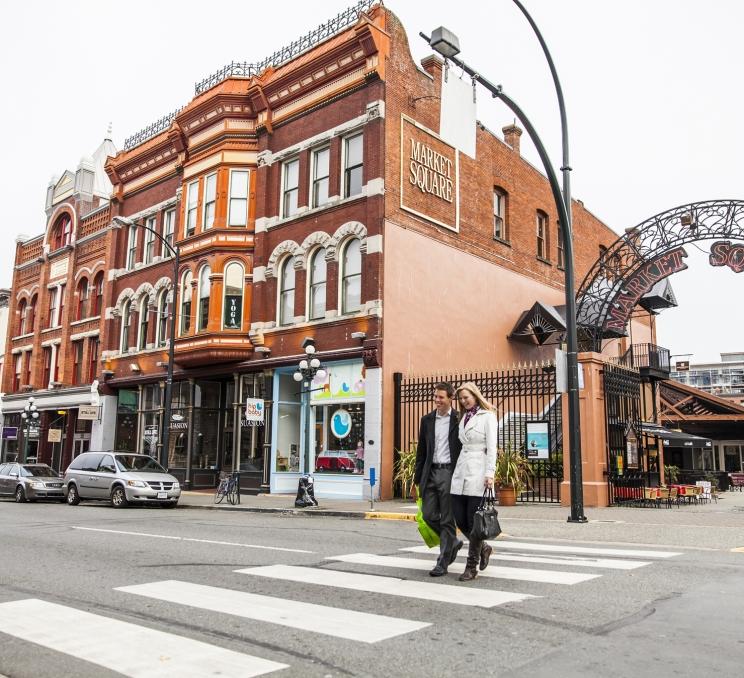
Shop Resale in Victoria
Victoria is known as the reuse capital of Canada, where people love finding cool stuff that's been used before. It's not just about being kind to the Earth; it's also about getting awesome things at good prices while helping out our city.
Sustainable Initiatives
Victoria leaves the buzzwords for the bees. Our journey has taken us from tide pools to treetops as we work to make each flight, each bite, and each night a little more sustainable than the last. If eco-conscious travel is at the forefront of your next great adventure, then Victoria is waiting for you!
Sustainability in Victoria + —
Sustainability and dgv + —, sustainability and the vcc + —, biosphere certification + —, impact: sustainability, travel and tourism conference + —, responsible travel itinerary.
Destination Greater Victoria is proud to be Climate Positive and is a Biosphere Certified Destination. In a city surrounded by water and connected to nature, you’re never more than a stone’s throw from innovative, one-of-a-kind, local businesses that put sustainability first, including hotels, restaurants, and world-class attractions.
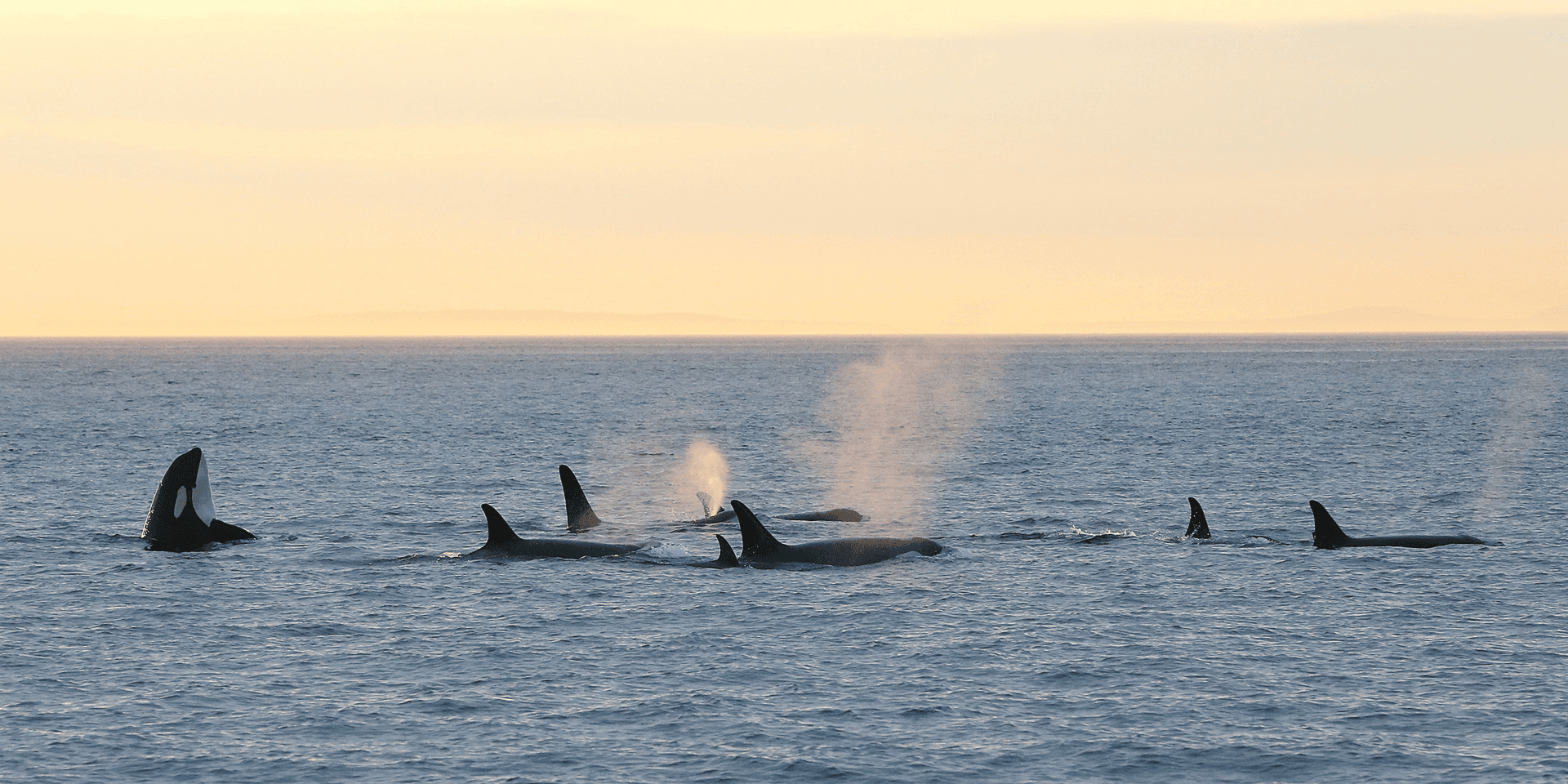
Blog: Sustainable Travel in Victoria, BC
Home to expansive green spaces, old growth forest, abundant local wildlife and seemingly never-ending shoreline, it’s easy to relax and feel connected to the earth on Vancouver Island. But Victoria takes “green” to a whole new level – we’re also a national leader in environmental initiatives, working in concert with many partners that share a commitment to sustainability.
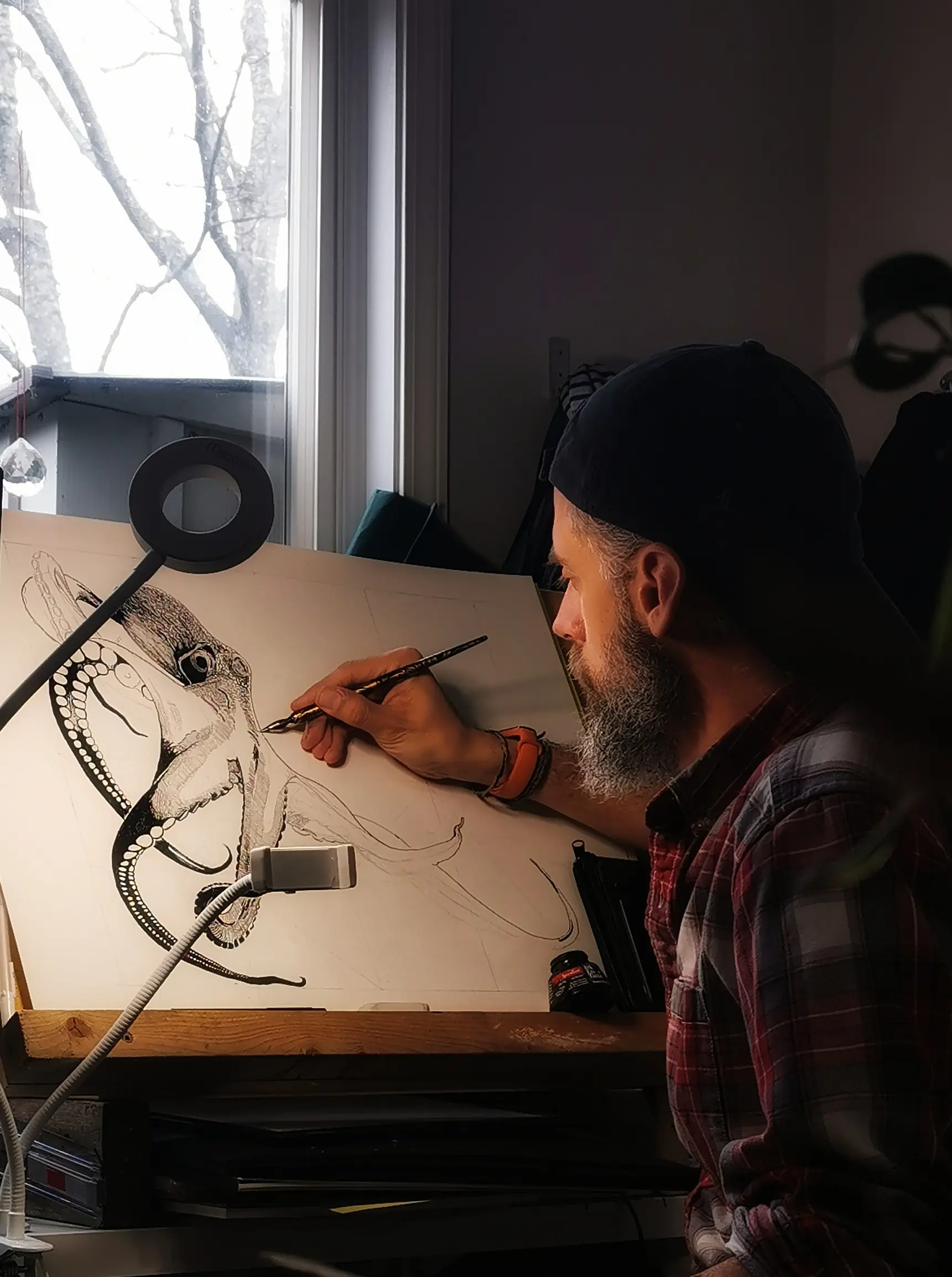
Download Victoria's Vacation Guide
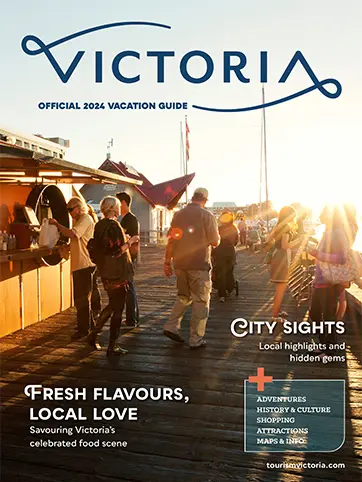
Navigate our map of Greater Victoria
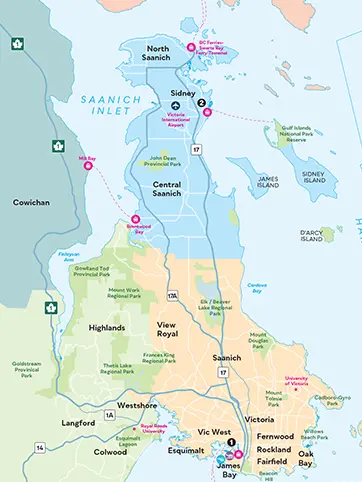
Victoria Visitor Centre
812 Wharf Street Victoria, B.C.
More Greater Victoria
- Travel Tips
Corporate Hub
- Corporate Destination Greater Victoria

- Skip to main navigation
- Skip to main content
- Skip to footer

Innovation and investment
We’re fast-tracking Victorian businesses to eliminate waste.

Cutting waste to boost the bottom line
We’re helping Victorian businesses make circularity a competitive advantage. Here's one online marketplace helping fashion labels sell leftover fabric to save money and reduce waste.

Working together for a sustainable economy
Business, industry, government, and consumers must work together to transition to a circular economy and do business differently.

First movers take on food waste
There are opportunities for circularity in every industry. From spilt milk to undersized cherries, these businesses are finding a way to divert food waste from landfill, saving money and creating new revenue streams in the process.

Investing in innovation
From healthcare to fisheries, we’re advancing the blue-sky thinking we need to transition to a circular economy.

New business models to transform ‘waste’ of the future
Getting more electric vehicles on the road is crucial for Australia’s transition to a sustainable future.

The linear economy is dead
Wayne Hubbard on the global trends for circular business models for Victoria’s sustainable future.

IMAGES
COMMENTS
Annual Business Plan 2021-22 Sustainability Victoria 2022. Authorised and published by Sustainability Victoria, Level 12, 321 Exhibition Street Melbourne, Victoria 3000 Australia. Accessibility This document is available in PDF and Word format on the internet at www.sustainability.vic.gov.au. ISBN 978-1-920825-69- (PDF)
Our Strategic Plan (2024-2027) outlines key delivery priorities for the next 3 years and how we will shape Victoria's circular economy on behalf of state government. Transitioning to a circular economy is essential to address the impacts of climate change and to achieve net zero emissions by 2045. This plan outlines the role Sustainability ...
Sustainability Victoria Business Plan 2019-20 (pdf, 4.3 MB) Sustainability Victoria Business Plan 2019-20 (docx, 745.4 kB) Sustainability Victoria Business Plan 2018-2019 Thank you for your feedback
Sustainability Victoria (SV) is a statutory agency of the Victorian Government, established in 2005 under the Sustainability Victoria Act 2005 (SV Act). Our long-term purpose is to accelerate Victoria's transition to a circular, climate resilient and clean economy - thereby contributing to
The budget expenditure for Sustainability Victoria's 2019-20 Business Plan is $63,989,039. Sustainability Victoria's legislated landfill levy distribution for 2019-20 is estimated to be $19,104,919. 2019-20 Expenditure per Funding Source. Act on Climate Change $. Use Resource Wisely $.
Overview. SV2030: A Decade of Action is Sustainability Victoria's organisational strategy for 2021 through to 2030. It sets out our vision to act on sustainability by working better with all Victorians, so that we can achieve greater impact through our mandated work. It also sets out SV's focus areas - these outline how we plan to ...
14 Business Plan 2018-19. Solar Victoria. On 19 August 2018, the Victorian Government announced a one-year Solar Homes package, consisting of a 50% rebate for solar PV systems (up to a value of $2,250) and $1,000 for solar hot water systems. The Victorian Government has allocated $74 million to Sustainability Victoria to deliver the Solar ...
Our yearly business plans; Sustainability Victoria Strategic Plan 2015-2020; Sustainability Victoria Strategic Plan 2015-2020. Last updated: 7 August 2023 Share Print Share. SV2020 builds on the direction of Towards SV2020 and incorporates practical approaches to a sustainable, low emissions Victoria. Facebook; Twitter; Linkedin ...
Sustainability Victoria. 6 Dec 2023. To be ready for a future shaped by climate change, Victoria needs to do business differently, and avoiding waste is a critical change we need to make. Innovative Victorian businesses are already reducing waste and saving money by testing new approaches to sustainability, transforming the way they use ...
Our purpose is to accelerate Victoria's transition to a circular, climate-resilient clean economy - contributing to achieving the Government's targets for 2025 and 2030 as set out in the Recycling Victoria policy and the Climate Change Strategy. Our ambition is to develop and deliver fit-for-purpose high impact solutions to challenges ...
Find out what incentives are available for becoming a more sustainable business. Learn about 5 star sustainability and save your business money. Reduce use. ... Business Victoria 13 22 15. Translation and Interpreting Services 131 450 or tisnational.gov.au. Deaf, hard of hearing, or speech communication difficulty? ...
LED lighting is much more efficient than fluorescent or halogen lighting and also needs less maintenance. Switching to LED globes could save an average small business up to $4,000 a year as well reducing greenhouse gas emissions by as much as 30 tonnes. High-efficiency LED lighting can replace light globes, downlights, fluorescent tubes, low ...
Sustainability Victoria
The City of Victoria cares about sustainability and climate change and wants to inspire and aid citizens and businesses to live more sustainably. In 2017, they create a Climate Leadership Plan, full of goals, targets, and information on how the City aims to minimize the effects of climate change through early and wise actions now.
Buying property off the plan In your business Back; In your business overview; Understand your energy bill Measure and monitor energy use ... Sustainability Victoria's ResourceSmart Schools Awards marked 15 years of celebrating sustainability leadership and action in Victorian schools.
2. Cut costs and waste with sustainable options. The move to durable, sustainable, recyclable and reusable materials reduces environmental pollution, reduces the volume of waste going to landfill and helps avoid contamination at recycling facilities not geared to handle plastic bags.
Destination Greater Victoria is proud to be Climate Positive and is a Biosphere Certified Destination. In a city surrounded by water and connected to nature, you're never more than a stone's throw from innovative, one-of-a-kind, local businesses that put sustainability first, including hotels, restaurants, and world-class attractions.
The conversation on sustainability is changing. State of Sustainability 2023 comes 15 years after Sustainability Victoria first benchmarked the attitudes of Victorians in the 2008 Greenlight Report. In that time, the conversation on sustainability has evolved. We've seen the emergence of new ideas, technologies and innovations shaping what a ...
Step 2: Describe your sustainable practices and strategies. The second step is to explain the sustainable practices or programs you want to implement. For each sustainability initiative, it's crucial to explain what you're currently doing, what you hope to achieve, and what steps you need to take to get there.
Sustainability Victoria: Annual Business Plan 2021-22 (excluding all trademarks and logos) is licensed under a Creative Commons Attribution 4.0 International licence. In essence, you are free to copy, distribute and adapt the work, as long as you attribute the work and abide by the other licence terms. Go to
Plan your short-term, mid-term, and long-term goals, including choosing your location; the number of customers you plan to reach and your customer demographics; your sales targets - revenue and profit margins; what you will outsource; your required staff numbers; and your growth strategy. Planning this strategy will help realise your dream and ...
Sustainability Victoria Impact Report An overview of our work in 2022-2023 Our goal is to become Australia's most sustainable state by 2030, and a global leader in sustainability solutions by 2045. Our purpose is to accelerate Victoria's transition to a circular, climate-resilient, clean economy - contributing
Buying property off the plan ... Wayne Hubbard on the global trends for circular business models for Victoria's sustainable future. ... Sustainability Victoria acknowledges Aboriginal and Torres Strait Islander people as the Traditional Custodians of the land and acknowledges and pays respect to their Elders, past and present. ...